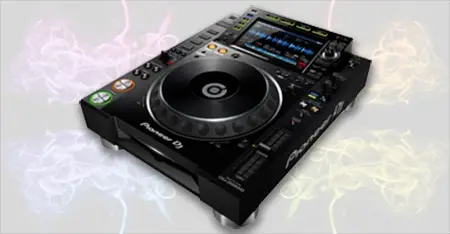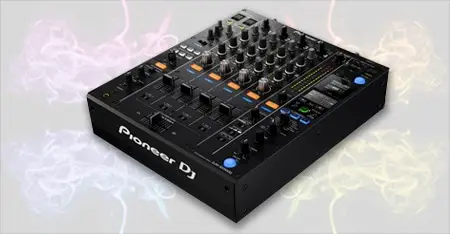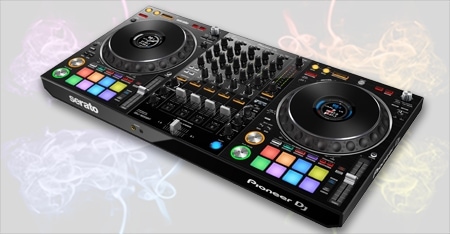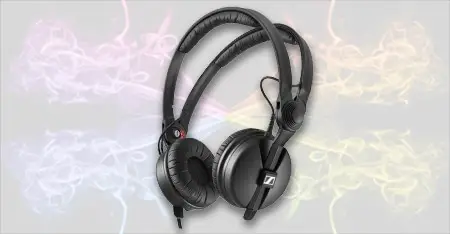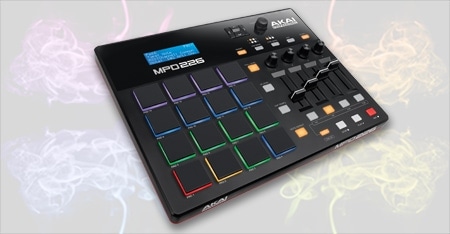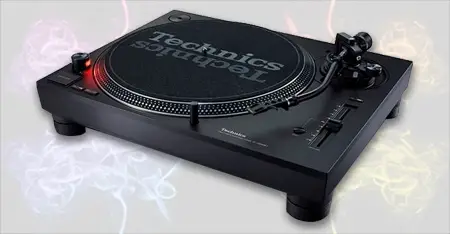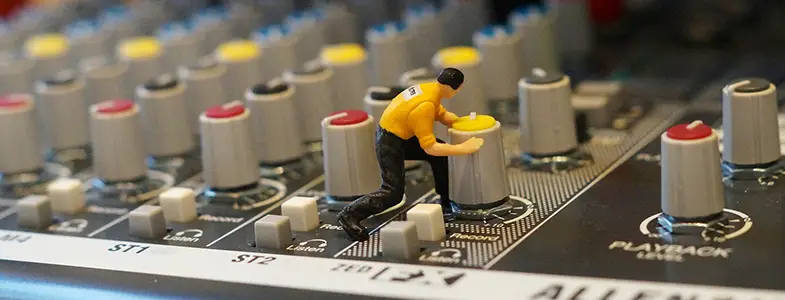
A mixer is one of those items you will have seen all over the place. They are a vitally important part of both DJ and studio setups. But what does a mix do? Why are there so many knobs on a mixer? What is actually going on?
Mixers are essential to any DJ setup. They take multiple audio inputs and merge them together into one. Before outputting a DJ (or sound engineer) can tweak the frequency of the audio using either EQ or FX controls. The mixer is then routed through a sound system so that the audience can hear what the DJ is playing.
They are not as complicated as they may look so let’s break them down so you get a full understanding of what a mixer does.
What Does a Mixer Do in General
Contents

As the name implies the job of a mixer is to allow you to input various sources of audio and then control them and tweak them individually into one sound.
You can imagine this as a simple concept just with vocals and a guitar for example. You have a microphone fed into the mixer on one channel and then you have the guitar come in on another channel. A “channel” is simply the row of knobs your see in a vertical line on the box.
Having this separation between audio sources allows tweaking of things like volume before you send that sound out to the speakers.
This is why when you see a live band then the music actually makes sense. When mixed properly, you should be able to pick each individual instrument without one dominating the overall sound.
One way to imagine this would be a drummer who also sings. If you had just one microphone pointed at them it would be impossible to hear the singing over the drums.
This is where the mixer plays a key role.
You have a microphone attached near the drummer’s face and then separate mics on the drum kit. Using the mixer you can adjust the volumes of the drums and vocals individually to make sure they’re heard clearly.
This means that the audience would be able to clearly hear the singing over the sound of the drums.
To see the mixer I recommend head here.
What Does a Mixer Do? Over Complicates Things…Kindof
Mixers can be overwhelming and look complicated although they’re really not. It’s just that they accept many different audio inputs so they have different channels.
If there is a 20-piece band then you would need a big mixer to allow for all the instruments.
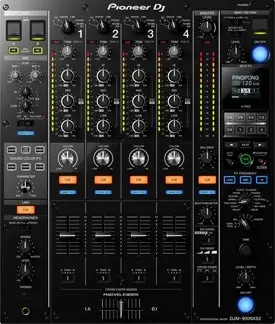
So if you look at a mixer this is exactly what they are. Simply the same row of vertical controls repeated again and again.
A DJ mixer will often only have two or four, whereas a studio mixer can have 36 or more. This gives a producer really fine control over all the different instruments and microphones that they might have setup.
Simply put, a mixer lets you take separate audio sources, tweak the sound and funnel it into one output.
What Does a Mixer Do Aside from Merge Audio?
It’s not only about controlling volume, however. A mixer can also add effects and adjust audio frequencies.
This means you’re able to turn down the bass, mid or treble of one channel independently of the other channels.
Another feature is that you can pan that channel to the left or right, this often happens in band music.
You might have a guitar for example, that during a solo, pans to the left and right in your headphones. This is one way of creating a sense of space and movement within the music.
Then, of course, there is a simple volume control which does exactly as you would expect. It allows you to turn up certain channels and turn other ones down.
Don’t ever be intimidated by how complex a mixer looks. Once you understand how one strip of controls works, you realize that the same strip has been repeated multiple times.
Let’s have a quick run through the basic functions of a mixer so that you fully understand what’s going on.
What Does a Mixer Do, Feature by Feature
The examples used below are a Yamaha MG20XU for the studio mixer, and the Pioneer DJM-900NXS2 (which isn’t actually my recommended mixer) for the DJ mixer.
Inputs
All mixers will have inputs and these are essentially where you plug your cables in. Each mixer normally has a couple of different types of plugs depending on what equipment you have.
Microphone leads tend to be a different adapter than DJ decks (see our recommended decks here) while guitars are different again. Therefore mixers vary in the type of inputs that they have.


Gain
Imagine Gain as a kind of overall volume for a channel. For example, if you take a quiet vocal, adds effects and to boost it then it will start to distort. Reducing the gain brings the overall level down to where the sound still has the effects but isn’t being distorted.


EQ
The EQ tends to be divided into three individual control knobs. One each for the Bass, Mid and Treble.
These allow you to tweak each frequency depending on how you want to affect the final output of that channel.
If something is being recorded without enough bass then you can turn that up as you need to. You may hear people talk about how “full” a sound is. It is the EQ that gives you control over that aspect.

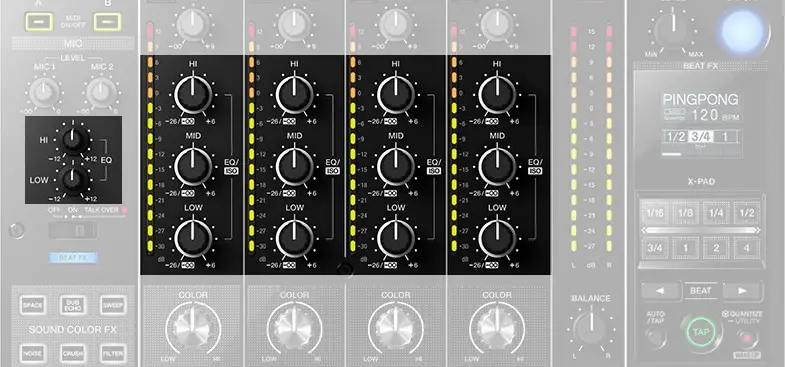
Pan controls
Pan is a short way of saying panorama. In short, it means whether the sound is sent to the left or the right speaker.
You can also input a sound twice, panning one left and one right, giving the impression of a “wide” sound.

Mute / Solo / On
Although the name might change, all mixers have a mute button on their channel, this is a quick way to solo an individual track.
Say you have five channels but wanted to listen to just one, perhaps the vocals, then this how you’d do it.
You would push mute on the other four so you can hear and tweak just the one. Some mixers have a “solo” button which is the inverse i.e you only have to push one button instead of four.


Vertical Slider
This controls the overall audio of that channel volume.
All mixers have a master volume as well and this is your way of controlling the final output. Whether you have taken two sources of audio, or ten, you can control the overall volume.
Mixers also have master outputs. This is the link to the speakers so the audience can hear the adjustments you made on the mixer.
Again, most mixers tend to have a couple of different outputs. These give you options when connecting to different types of speakers or PA systems.


Are All Mixers the Same Thing?
“Mixer” is a fairly general term. You’ll also hear them called “mixing consoles”, “audio mixer” or “soundboard”. They are all, however, the same thing.
Their sole purpose is combining different audio sources, editing the dynamics and output one piece of audio. Audio that is easy to listen to, and makes sense to listen to.
This is why they are a key component, not just in live music situations but also in TV and Radio studios.
Even a two-person conversation benefits from separate microphones. One may speak a lot quieter, so you can boost the volume of their channel to match the other.
Love DJ gear?
So do we, check out our favorites…
What Does a Mixer Do When It’s Digital? and What’s Different to Analogue Mixers?
Analog mixers are the originals and used to be the standard in studios all over the world.
However, as technology advanced we now have digital mixers that give you extra features.
There are plus and minus points to both.
One of the best features of digital mixers is the ability to save “projects”.
So after hours of sliding faders and moving pots to make everything sound just right, a producer can save the settings for later.
They can then load that project and all of the sliders and knobs automatically jump back into the same position. The producer can then carry on exactly where they left off.
Analog consoles are not able to do this as everything has to be done manually. Meaning the producer would have to make a note of every single setting, and then put it all back in manually.
When you are working with large desks, this can be very time-consuming.

Analog Desks Do Have Their Advantages Though
The biggest one being the warmth and depth of sound that analog has over a digital desk.
What does a mixer do to process the signal digitally?
This is because these digital mixers are processing the audio very much like a computer. The audio is processed in zeros and ones and this causes a slight loss of depth.
What does a mixer do to process the signal when it’s analog?
An analog mixer is made completely out of wires and components. Meaning the signal passed in, plus any tweaks & changes is the same signal that will come out.
And, because it wasn’t converted to ones and zeros then it retains the full depth and warmth of sound.
This is referred to as summing.
Analog desks are able to sum and combine signals which is something digital mixers have yet to convincingly replicate yet.
Why Do Mixers Vary?
While the basic functionality is always the same, there are slight variations in types of Mixer. Those you find at a DJ gig and or in a studio have slightly different aims.
Both have the same channels that allow you to input audio, effect it and then output audio. However, a DJ mixer has fewer channels and has additional features that a studio mix does not.
What Do DJs Mixers Do?
DJ mixes vary massively in how many features are included which is usually reflected in their price. Low-cost mix DJ mixers will few controls but, for simply mixing tracks together, will be just as capable as the most expensive models.
The most expensive mixers allow you to connect it to DJ software or into laptops. They also have more switches & features, giving more granular control over different parts of your track.

Crossfaders only exist on DJ mixersOne main feature that only a DJ mixer has is the crossfader. This is because the DJ needs to be able to quickly move from one channel/track to the other. A crossfader does this smoothly using just one slider instead of having to move two, as you would on a studio mixer.
Built-in Effects
Modern DJ mixers have essentially merged with controllers and many incorporate buttons for added functionality. The DJ can trigger things like additional sound effects from their laptops or things like echo or delay. These all help to add extra layers to their DJ sets.
Some even go as far as to integrate controls for your video clips or light show.
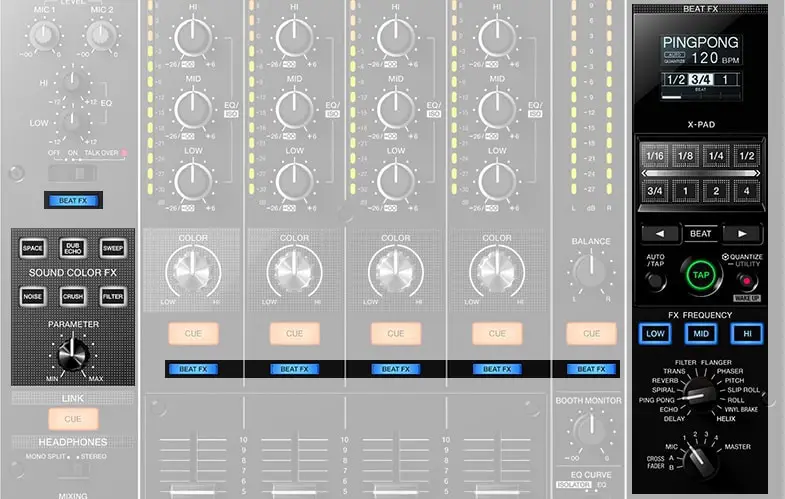
Studio mixers tend not to have these.
Instead, extra sounds are added through a separate channel which gives you more granular control. Studio engineers can tweak things carefully while a DJ is doing everything live so needs everything at their fingertips.
Remember you can see my recommended mixer here.
What Does a Mixer Do in Software?
With a decent laptop and audio software, you can process and mix audio in the same way as a physical mixer.
In fact, all music production software such as Ableton, FL Studio and Cubase include mixers as part of their interface. This is how you adjust the final output of the songs or audio that you have created.
They allow you to control all the elements of drums, samples, vocals or instruments to create a cohesive sound that sounds balanced to you.
And hopefully, make sense to your listeners.
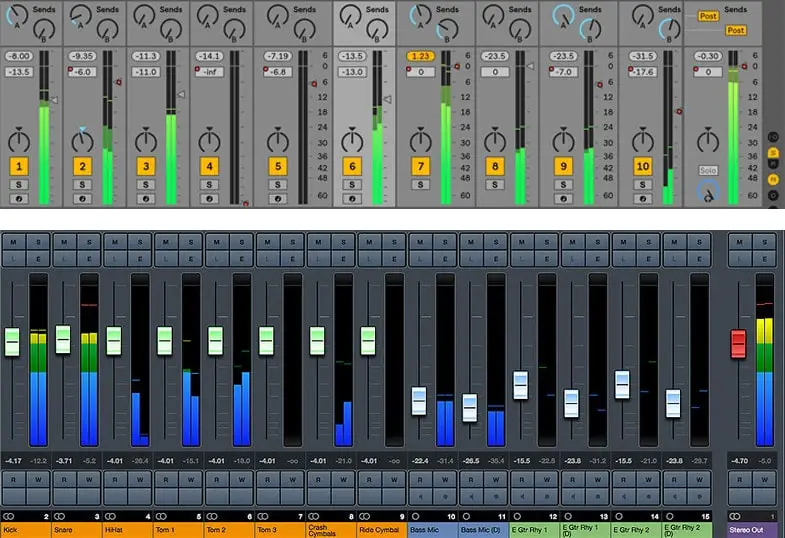
So, What does a Mixer Do?
Although mixers vary massively in how they look and features at the very basic level they all do the same thing. Every single mixer, whether DJ or studio, allows you to take multiple audio sources and then edit or tweak them individually. They are then output as merged one audio source that you can send to speakers for your audience to hear.
Hopefully, this guide has gone some way to answer how mixers work and some of their functions.
Remember there’s no better way to learn than to get your hands on them and to start playing around. As long as you are careful then you can’t really break anything, but you can learn a whole lot!
What Next?
- If you have any questions then please drop them below and I’ll answer every single one.
- Not sure what a DJ does? Then get that question answered here.
- Starting out and need a DJ name? Check out this monster guide.

